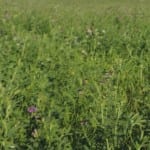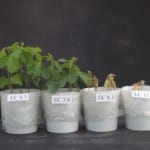Salt-Affected Soils Research Projects

Defining Wheat Response to Salinity for North Dakota.
ND Wheat Commission, 2014-2015, $27,719
(A.F. Wick, A. Chatterjee, D. Ripplinger and J. Harmon)

Improving Soil Health and Productivity of Sodic Soils.
ND Soybean Council, 2014-2015, $69,944
(T. DeSutter, A. Chatterjee and A.F. Wick)

Developing Treatments of Interest to Producers at the SHARE Farm.
ND Soybean Council, 2014-2015, $62,707
(A.F. Wick, F. Casey and T. DeSutter)

Influence of Soil Salinity Gradients on Corn Production and Arthropod Pest Infestations.
ND Corn Council, 2013-2014, $53,219
ND Corn Council, 2014-2015, $72,540
(A.F. Wick, J. Harmon, D. Prischmann-Voldseth)
From the Ground Up: How do Soil Salinity Gradients Damage Soybeans, Contribute to Arthropod Pest Infestations and Impact Soil Nitrogen Reserves.
North Dakota Soybean Council, 2013-2014, $58,213
(A.F. Wick, J. Harmon, D. Prischmann-Voldseth)
The primary goal of this research is to gain a better understanding of the anticipated interaction among soil salinity gradients, corn and soybean yield reductions and stress levels, and pest infestation by two-spotted spider mites (Tetranychus urticae). A secondary goal is to improve our understanding of soil nitrogen dynamics under soybean plants exhibiting various levels of stress. Ultimately, we hope to provide producers with the information needed to manage a field from a “soil perspective” for pest infestations and nitrogen fertility levels to achieve optimal productivity.

Effect of Salinity on Disease Resistance of Soybean.
ND Soybean Council, 2014-2015, $37,500
(B. D. Nelson and A.F. Wick)

Reducing Sodification in High Risk Northern Great Plains Soils
USDA-NRCS Conservation Integration Program, 2012-2015 $915,785
(T. DeSutter, D. Clay, D. Franzen, D. Roberts, J. Hadrich, F. Casey, L. Cihacek, A.-M. Fortuna, D. Steele, Z. Lin, S. Clay, G. Carlson, D. Malo, K. Reitsma)
This research will determine which soil health parameters are affected by tile drainage and other measures taken to remediate saline sodic soils. The goal is to provide a set of best management practices that will allow for remediation and improvement of the soil health of saline sodic soils without adversely affecting water quality

Establishment of the NDSU Soil Health and Agriculture Research and Extension (SHARE) Farm
ND Corn Council, 2013-2014 $68,950
(A. Wick and F. Casey)
The development of this research and extension farm will (1) increase our ability to demonstrate and evaluate a combination of management strategies for saline, sodic, and saline-sodic soils at a single location, (2) facilitate interdisciplinary research and extension efforts related to these issues, (3) improve our ability to conduct field-scale research, and (4) allow us to conduct long-term research on management strategies for problematic soils.
Energy beet utilization as a saline soil bioremediation species and high value livestock feed
North Dakota Agricultural Products Utilization Commission, 2013-2014, $68,820
(M. Ostlie, V. Anderson, and J.M. Teboh)
The goal is to use salt tolerant energy beets as bioremediation crops in unproductive salt affected and at risk saline soils in North Dakota. The objective is to screen energy beet germplasm for their inherent tolerance to soil salinity, and to define salinity tolerance of energy beet at different salt levels to enable the prediction of yield potentials under saline conditions. By growing energy beet in otherwise unproductive fields, thereby keeping soil covered, producers would be able to reap some benefits from their investments and improve soil structure, water infiltration and enhance leaching of salts during rainfall events.